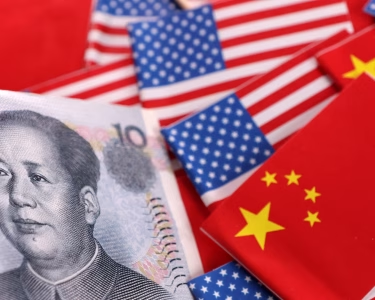
Major stock indexes and U.S. share futures plunged on Monday, with the S&P 500 poised to confirm a bear market, and volatility gauges spiked as U.S. President Donald Trump showed no sign of backing away from his sweeping tariff plans.
Investors also bet the mounting risk of recession could see the Federal Reserve cutting interest rates as early as May, and futures markets moved swiftly to price in almost five quarter-point cuts in U.S. rates this year, hurting the dollar on safe havens.
The carnage came as Trump told reporters that investors would have to take their “medicine” and he would not do a deal with China until the U.S. trade deficit was sorted out.
“We’re in the territory where this will be a named event when people write about things in 10 or 20 years time,” said Tim Graf, head of macro strategy EMEA, State Street, adding that last week’s selloff was being exacerbated by two things.
“Things become reflexive – derisking leads to derisking – and even though individual actors in markets think they are doing the rational thing, when they all do the same thing at the same time, it becomes irrational on the surface, a sort of tragedy of the commons.”
“And secondly there is an intransigence element that will come to the fore because these guys (U.S. policymakers) don’t sound like they are going to change their minds.”
Investors had thought the loss of trillions of dollars in wealth and the likely body blow to the economy would make Trump reconsider his plans.
RELATED: Stocks slide on Chinese data, US debt ceiling worries hit T-bills
“The size and disruptive impact of U.S. trade policies, if sustained, would be sufficient to tip a still healthy U.S. and global expansion into recession,” said Bruce Kasman, head of economics at JPMorgan, putting the risk of a downturn at 60%.
S&P 500 futures slid 2.6% in volatile trade, while Nasdaq futures dropped 2.9%, both down less than in early Asia trade but still suggesting sharp falls at the open on top of last week’s almost $6 trillion in market losses.
The VIX (.VIX), opens new tab “fear index” of volatility also surged, rising as high as 60 for the first time since August, and signs of stress were also seen in credit markets.
The pain likewise engulfed European stocks, with the broad Stoxx 600 down 4%, with recent market darlings particularly hurt as investors were forced to sell what they owned.
Defence stocks tumbled 5.5%, (.SXPARO), opens new tab while banks shed 4.5% on the day and are down more than 20% from their recent closing high (.SX7P), opens new tab, on course to confirm they are in a bear market.

In Asia, Hong Kong’s Hang Seng’s (.HSI), opens new tab 13% one-day slump was the largest since 1997, while in mainland China the blue-chip CSI 300 (.CSI300), opens new tab index was down 7% only finding a floor when state media reported China’s sovereign fund Central Huijin was a buyer.
week.
Brent fell $1.46 to $64.12 a barrel, while U.S. crude lost $1.60 to $60.43 per barrel.
NEVER MIND INFLATION
Growth fears caused Fed fund futures to price in an extra quarter-point rate cut from the Federal Reserve this year, and markets swung to imply around a 50% chance the Fed could cut interest rates as soon as May.
That was despite chair Jerome Powell on Friday saying the central bank was in no hurry to cut rates, though in a sign of a possible conflict to come, Trump reiterated in a Monday social media post his view that the Fed should cut rates.
Higher rate cut bets gave a boost to Treasuries in early trade and the 10-year yield neared Friday’s six-month low of 3.86%, though the move failed to hold and the benchmark was last flat on the day at 3.992%.
The rebound brought the dollar off its early lows against safe haven currencies, but it was still down 0.3% on the Japanese yen at 146.4 , and 0.6% on the Swiss franc at 0.8556.
The euro was steady at $1.1005 , seemingly benefiting from some nervousness about the dollar.
Investors were also betting that the imminent threat of recession would outweigh the likely upward shove to inflation from tariffs.
RELATED: Markets make a dicey bet on art of the trade deal
U.S. consumer price figures out later this week are expected to show another rise of 0.3% for March, but analysts assume it is just a matter of time before tariffs push prices sharply higher, for everything from food to cars.
Rising costs will also put pressure on company profit margins, just as the earnings season gets underway with some of the big banks due on Friday. Around 87% of U.S. companies will report between April 11 and May 9.
Analysts at Goldman Sachs said in a note they expect fewer companies than usual to offer guidance about their results for the second quarter or the year as a whole.
As well as inflation data, investors will be watching scheduled U.S. government bond auctions. A poor outcome “will be jumped on by investors” and would be negative for the dollar, said ING.
Even gold was swept up in the selloff, easing 0.3% to $3,026 an ounce .
The drop left dealers wondering if investors were taking profits where they could cover losses and margin calls on other assets, in what could turn into a self-feeding fire sale.




